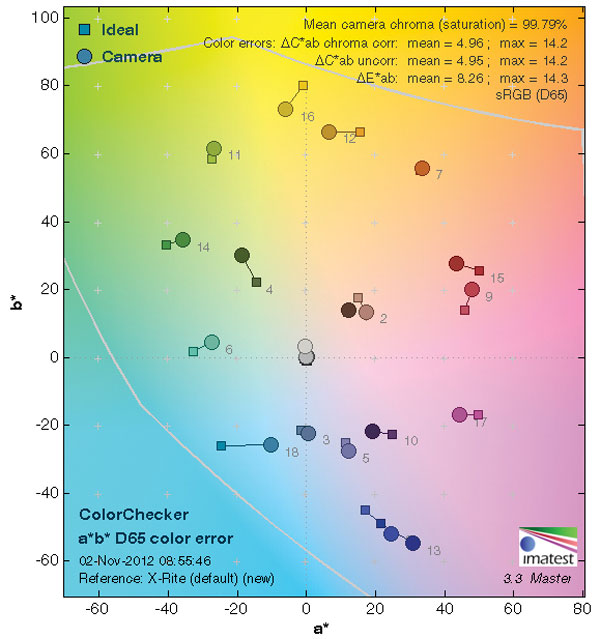Panasonic GH3 Mirrorless Camera Review
The Panasonic GH3 has a brand-new body based on a magnesium-alloy chassis. This Micro Four Thirds camera is bigger than its forerunner and has nearly the same dimensions as a small APS-C SLR system; in fact, it is even bigger than the Nikon D3200. The body is very robust and has numerous functional elements for comfortable handling, including up to five user-defined Fn buttons. Large mode and parameter dials allow for fast setup of all parameters such as shutter speed and aperture settings.





The camera has a brand-new OLED viewfinder with 1.744 million RGB dots and displays a remarkably high quality and shows very brilliant and crisp viewfinder images. Manual focusing is easy with this sharp display. Nevertheless, a “focus peaking” function is missing: most professional camcorders and some Sony SLT cameras offer this function, which emphasizes contrast lines by a colored contour when the line is perfectly in focus. This would be a fine feature for a professional camera with an electronic viewfinder.
While the electronic viewfinder offers a very high resolution, the display on the back has only a standard resolution of 614,000 RGB dots yet it also offers a very bright and brilliant reproduction of the image because it is also based on OLED technology. This swivel monitor is touch sensitive and allows the user to change image parameters or the chosen focus area, for example, with the single touch of a fingertip. The swivel mechanism is located on the left-hand side of the camera and allows for a comprehensive adjustment of the screen to the side, to the front, upward, and downward.
The camera can record Full HD video with 1920x1080 pixels. It offers standard AVCHD 2.0 modes with up to 50 frames per second and additional MP4 modes with extremely high bit rates (up to 72 Mbit/s) and intra-frame recording (ALL-I) mode. This helps to prevent compression artifacts and will produce high-quality movies, but also requires very fast SD cards and high storage capacity. The camera has microphone input and earphone output jacks for better sound recording.
The camera has a Wi-Fi module that wasn’t usable in Version 0.5 of the firmware tested but we are sure it will be fully functional when the camera is widely available. Panasonic will offer apps for smartphones and tablet computers that will allow wireless remote control and image data transfer to phones or network computers.

Image Quality
Color: The GH3 tends toward warmer colors than the GH2. Based on our GretagMacbeth test chart, the camera’s auto white balance system showed a nearly perfect performance. Nearly all neutral gray patterns are located exactly in the center of the chart with only the brightest nuances showing a tendency into the yellow-colored area. The saturation is nearly perfect at 99.79 percent; actually, it’s even a little too low when compared to compact cameras. Skin tones are very fine even though the camera sometimes shows the “classic Panasonic look” with a little too high magenta rate in darker skin tones. The differentiation of red nuances is very good, evidenced by the red spool in the standard test box shot.

Sharpness: The sharpness results are very good. The camera was tested with the Lumix G Vario 14-140mm f/4.0-5.8 lens and gained a maximum of 3136 lines in picture height, which is a high result for a camera with a nominal sensor resolution of 3456 lines in picture height. This result is also a consequence of a high electronic sharpening, which sometimes causes some over- and undershot effects on hard contrast lines, such as the black and white lines in the standard test image. The standard test image itself has a slightly soft look, while the hair and the fabric of the T-shirt in the portrait shot display a very crisp appearance.
Noise: The camera showed a remarkably good result in the noise tests. The luminance noise is on a very low level in lower ISO speed settings. Color noise is also on a low level and needs less anti-noise filtering, so images taken with ISO speed settings up to ISO 3200 look smooth and clear. In the highest ISO speed settings you will notice the common anti-noise filtering effects and a reduction of detail reproduction.

With the new image sensor of the GH3, Panasonic brought forth a higher dynamic range. Essentially, the maximum dynamic range is really higher: while the GH2 offered a maximum of 10.3 f/stops, the GH3 tested with a maximum of 11.3 f/stops. That’s a very good result.
Scorecard
Pro
+ Very massive, robust new body based on a magnesium-alloy chassis
+ Nice color reproduction
+ Increased dynamic range (compared to the forerunner GH2)
+ Professional handling due to robust body, many function elements, setup dials, and so on
+ Professional video capabilities, including high image rate modes (up to 50 frames per second progressive recording) as well as high bit rate modes (up to 72 Mbit/s) and intra-frame recording modes
+ Wi-Fi module will be available (not tested)
Con
- Some aliasing and moiré effects in videos
The Panasonic GH3 has a list price of $1299. For more information, visit www.panasonic.com.
Image Tech is where we publish web-exclusive lab reports on cameras. To read the reports please go to the Shutterbug homepage at www.shutterbug.com and click on the Image Tech tab on the top navigation bar. New reports are published frequently, so check Image Tech for updates.
Lab results and test images by BetterNet, our TIPA-affiliated testing lab. Edited by George Schaub.
















































